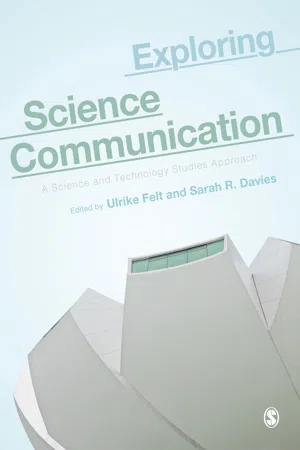
eBook - ePub
Exploring Science Communication
A Science and Technology Studies Approach
This is a test
- 264 pages
- English
- ePUB (mobile friendly)
- Available on iOS & Android
eBook - ePub
Exploring Science Communication
A Science and Technology Studies Approach
Book details
Table of contents
Citations
About This Book
Exploring Science Communication demonstrates how science and technology studies approaches can be explicitly integrated into effective, powerful science communication research. Through a range of case studies, from climate change and public parks to Facebook, museums, and media coverage, it helps you to understand and analyse the complex and diverse ways science and society relate in today's knowledge intensive environments. Notable features include:
- A focus on showing how to bring academic STS theory into your own science communication research
- Coverage of a range of topics and case studies illustrating different analyses and approaches
- Speaks to disciplines across Media & Communication, Science & Technology Studies, Health Sciences, Environmental Sciences and related areas.
With this book you will learn how science communication can be more than just about disseminating facts to the public, but actually generative, leading to new understanding, research, and practices.
Frequently asked questions
At the moment all of our mobile-responsive ePub books are available to download via the app. Most of our PDFs are also available to download and we're working on making the final remaining ones downloadable now. Learn more here.
Both plans give you full access to the library and all of Perlego’s features. The only differences are the price and subscription period: With the annual plan you’ll save around 30% compared to 12 months on the monthly plan.
We are an online textbook subscription service, where you can get access to an entire online library for less than the price of a single book per month. With over 1 million books across 1000+ topics, we’ve got you covered! Learn more here.
Look out for the read-aloud symbol on your next book to see if you can listen to it. The read-aloud tool reads text aloud for you, highlighting the text as it is being read. You can pause it, speed it up and slow it down. Learn more here.
Yes, you can access Exploring Science Communication by Ulrike Felt, Sarah R. Davies, Ulrike Felt,Sarah R. Davies in PDF and/or ePUB format, as well as other popular books in Social Sciences & Sociology. We have over one million books available in our catalogue for you to explore.
Information
Table of contents
- Cover
- Half Title
- Acknowledgements
- Title Page
- Copyright Page
- Contents
- About the Editors and Contributors
- 1 Introduction
- Part I STS Concepts And Sensitivities
- 2 Conceptual Framings: STS Research for Science Communication
- 3 What Does an STS Approach to Science Communication Look Like?
- Part II Mobilising STS concepts and sensitivities: The Case Studies
- 4 Object Biographies: The Life of a Hacked Gene Gun
- 5 Public Science and Public Space: Communicating Ecologies through Landscape Design
- 6 Visual Climate Communication: Making Facts and Concerns in Popular Science Magazines
- 7 Public Health Communication: Anecdotal Evidence and Responsibility in Print Media Accounts of Obesity
- 8 Constructing Science in Public: Framing Synthetic Yeast in News Media
- 9 Science, Emotion, and Identity Online: Constructing Science and Selves on ‘I Fucking Love Science’
- 10 Co-producing Knowledge and Nation-states: Nutrition Communication and the Making of Citizens
- 11 Communicating Forensic Genetics: ‘Enthusiastic’ Publics and the Management of Expectations
- Part III Concluding Thoughts
- 12 Connections, Assemblages, and Open Ends
- Index